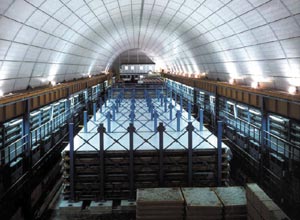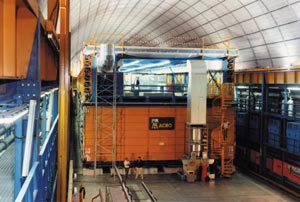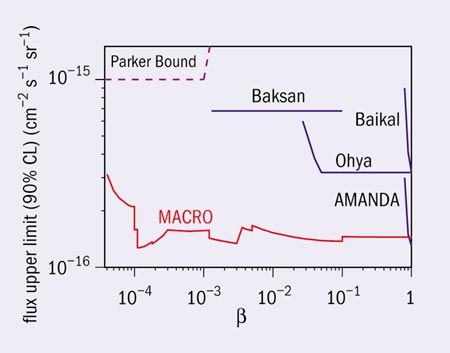The MACRO experiment searched for magnetic monopoles throughout the 1990s. It found none but set stringent limits.
MACRO, the Monopole, Astrophysics and Cosmic Ray Observatory detector, ceased operation two years ago. As its name makes clear, one of MACRO’s main aims was to search for magnetic monopoles, and recently the MACRO collaboration published the final results of their direct monopole search. It found none, but set the most stringent upper limits on their existence so far, and at the same time set upper limits on nuclearites.

MACRO was located in Hall B of the Gran Sasso Underground Laboratory, under about 1400 m of rock, which reduced the cosmic ray flux to about 1 muon per square metre per hour, or about one million times less than the flux at the Earth’s surface. The detector had a modular structure, with a total volume of 76.5 x 12 x 9.3 m3 and a total acceptance of about 10,000 m2 sr. It used three types of subdetectors – liquid scintillation counters, limited streamer tubes and nuclear track detectors – and was operational from 1989 until the end of 2000.
The magnetic monopole is a hypothetical particle with a single magnetic charge. Classically, such particles are expected in analogy with electrically charged particles, and in order to symmetrize Maxwell’s equations. However, experiments indicate that in nature magnetic effects are due only to magnetic dipoles, which are created by moving electric charges.
Nevertheless, in 1931, while attempting to find a theoretical motivation for the quantization of electric charge, Paul Dirac found a relationship that quantizes the product of a basic electric charge e, times a basic magnetic charge g – namely, eg/c = nh/4π, with n = 1, 2, 3,…. In this case, the quantization of electric charge follows from the existence of a magnetic charge. Moreover, if the basic electric charge is that of the electron, in the symmetric cgs system of units, then the basic magnetic charge is g = 68.5e. This is a large value, and it introduces a numerical asymmetry between electric and magnetic phenomena; it also leads to a large magnetic coupling constant. Such “classical Dirac magnetic monopoles” have been searched for at every new higher energy accelerator, but without success.

During the 1970s, monopoles appeared on the scene again, when theorists found that electric charge is naturally quantized in gauge theories that unify the strong and the electroweak interactions (GUTs). These theories require magnetic monopoles of very large mass, ~1017 GeV. Such a mass cannot be produced at any of our accelerators, existing or planned, but the heavy monopoles could have been produced in the early universe, and could still exist as relic particles in the penetrating cosmic radiation.
MACRO searched for superheavy magnetic monopoles using its three types of subdetectors, either on a stand-alone basis or in combination. It also used different and redundant electronics, which allowed searches in different velocity ranges, cross checks and background studies. No candidate monopole was found, with an upper limit at the 90% confidence level of a flux level of 1.4 x 10-16 cm-2 s-1 sr-1 for monopoles with velocity between 4 x 10-5 c to c and magnetic charge with n >= 1 (Ambrosio et al. 2002a). Some indirect searches may yield stronger limits, but only after making several hypotheses that can’t be checked.

The GUT monopole is a complicated object with a very small core and different surrounding regions. If a proton were to hit a monopole core it would catalyse the decay of the proton (Mp → Me+π0). Because of the smallness of the monopole’s core this should be a very rare phenomenon, but if there are baryon number violating terms in the four-fermion virtual condensate around a GUT monopole of up to 1 fm radius, the cross-section could be large and the phenomenon could be observed. MACRO made a dedicated search for this using the streamer tube system and looking for a fast track originating from a slow (10-4 < ß 10sup>-3) incoming particle – the possible monopole. The search excluded large cross-sections and again obtained the best existing limits (Ambrosio et al. 2002b).
As a by-product of these searches for magnetic monopoles, MACRO has also set stringent limits for other exotica, in particular nuclearites. Nuclearites (strangelets or strange quark matter) should consist of aggregates of u, d and s quarks. They would be colour singlets and could be the ground state of QCD. The overall electrical neutrality of strange quark matter would be insured by an electron cloud. Nuclearites could have been produced shortly after the Big Bang, at around the hadronization time, and may have survived as remnants to form part of the cold dark matter. When hitting the Earth with typical galactic velocities (ß ~10-3) they would not ionize, but excite atoms and molecules along their trajectories and should be easily detected in scintillators and nuclear track detectors. MACRO established upper limits at the level of 1.4 x 10-16 cm-2 s-1 sr-1. Nuclearites, like magnetic monopoles, could exist at lower levels than we can at present detect, if indeed they exist at all.
Further reading
M Ambrosio et al. 2002a Eur. Phys. J. C25 511.
M Ambrosio et al. 2002b Eur. Phys. J. C26 163.





